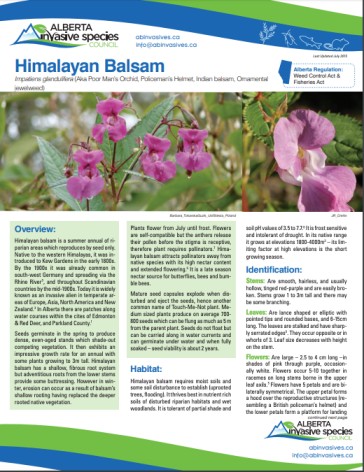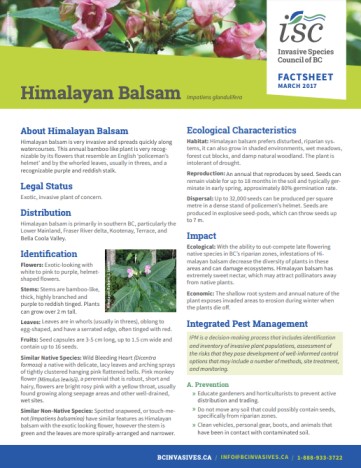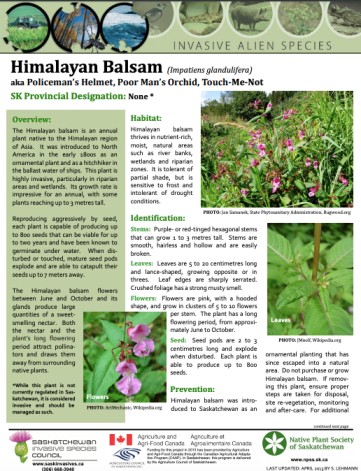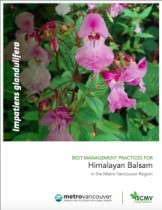Himalayan Balsam (Impatiens glandulifera)
French common name: Balsamine de l'Himalaya
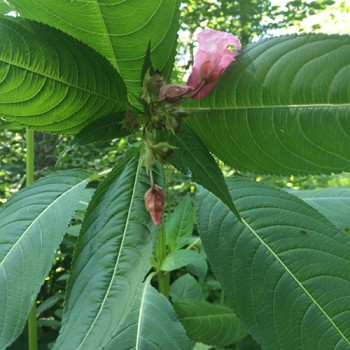
Himalayan balsam is an invasive herbaceous plant that was initially introduced to North America as a garden ornamental.
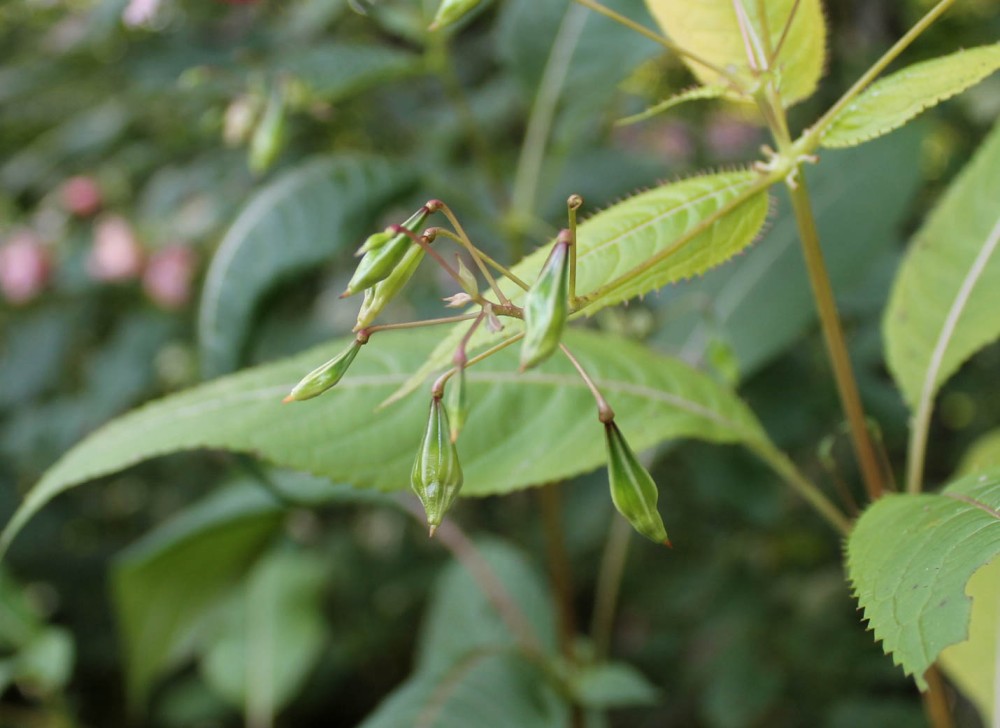
When seed capsules mature and dry, they will explode when touched, shooting seeds in all directions!
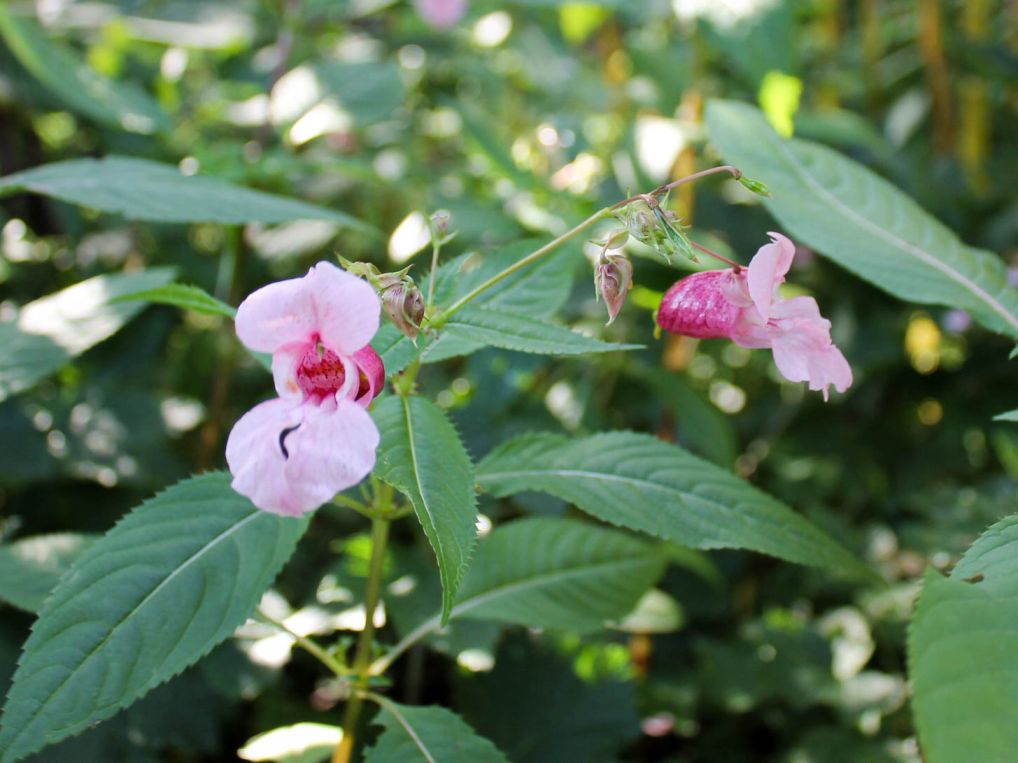
Himalayan balsam flowers have a hooded shape that looks similar to a policeman's helmet.
Order: Ericales
Family: Balsaminaceae
Did you know? Himalayan balsam closely resembles native jewelweed, another type of ‘touch-me-not’ plant.
Himalayan balsam is an invasive herbaceous plant that was initially introduced to North America as a garden ornamental. Himalayan balsam is widely distributed across Canada and can be found in eight provinces. Annual reproduction of this plant occurs in the summer, when the flowers are pollinated by insects. The insects may transfer pollen between flowers of conspecifics or from the same plant. Himalayan balsam typically grows to 1-3 m in height, with a soft green or red-tinged stem, and toothed leaves 5-23 cm long. The crushed foliage has a strong musty smell. Below the leaf stems the plant has glands that produce a sticky, sweet-smelling, nectar. Himalayan balsam flowers are pink, with a hooded shape, 3-4 cm tall and 2 cm broad; the flower shape has been compared to a policeman’s helmet. Himalayan balsam creates dense and tall stands that prevent native plants from establishing and reduce biodiversity. This plant is a prolific nectar producer and produces about 800 seeds per plant. This annual species can aggressively replace native perennial plants along riverbanks, leading to soil erosion.
Stem: The hollow, purple/reddish stem grow between 1-3 m tall.
Flowers: Himalayan balsam’s pink flowers are a key ID feature in the late growing season. The flowers have a hooded shape and look similar to a policeman’s helmet.
Leaves: This plant has long, toothed leaves 5-23 cm long.
Seeds: Himalayan balsam seed capsules will hold up to 16 seeds. This plant is a “touch-me-not” plant, which means that when its seed capsules mature and dry, they explode when touched. Seeds can spread up to 5 m from the parent plant.
Himalayan balsam is widely distributed across Canada and can be found all of provinces except Saskatchewan. It has naturalized in the United States.
Himalayan balsam produces dense stands, creating monocultures and reducing biodiversity by limiting nutrient and habitat availability and shading out native plants.
Himalayan balsam’s prolific nectar production draws pollinators away from other plants and is a main draw for gardeners wanting to attract more pollinating species. However, growing this plant should be avoided, as it spreads rapidly and will quickly overtake native species and reduce biodiversity.
One Himalayan balsam plant can produce over 800 seeds, allowing them to spread quickly – both naturally through wind and animal dispersal, and through human interference once the seed pods dry and explode when touched.
This species can aggressively replace native perennial plants along riverbanks, over time leading to soil erosion.
Mechanical control, by repeated cutting or mowing, is effective for large stands, but plants can regrow if the lower parts are left intact. Cutting the plant below the lowest node can help stop regeneration. Access to the sides of riverbanks can be difficult and inaccessible stands can quickly recolonise accessible cleared areas, so vigilance is needed if an area is to be effectively cleared.
Smaller infestations can be easily controlled by hand-pulling, as the root of Himalayan balsam is very shallow. However, management should only take place if there are no visible seeds, as disturbing the seeds can lead to further infestation in the disturbed soil. If management must take place when seeds are present (typically in late May), place a bag over the top of the plant to avoid further dispersal. As the seeds are not very robust and only last about 18 months, management can be completed in two years as long as proper disposal has occurred and all plants have been removed.
Once plants are removed, they should be placed in a black garbage bag and placed on an impermeable surface for up to 1 week. This will kill off any viable materials before disposal.
Fact Sheets
Best Management Practices and Technical Bulletins
Research
Population genetics of Himalayan balsam (Impatiens glandulifera): comparison of native and introduced populations
Better understanding of the evolution of such species will be useful when planning their
management and eradication. Aims: We aimed to compare patterns of genetic variability in …
The invasive alien plant, Impatiens glandulifera (Himalayan Balsam), and increased soil erosion: causation or association? Case studies from a river system in …
over the winter 2012/2013, found that riparian areas recently supporting the invasive plant
Himalayan Balsam (HB) recorded significantly higher erosion rates than nearby uninvaded …
The Potential for the Biological Control of Himalayan Balsam Using the Rust Pathogen Puccinia cf. komarovii: Opportunities for Europe and North America
native to the western Himalayas, which has spread rapidly throughout Europe, Canada and
the United States since its introduction as a garden ornamental. The plant can rapidly …
Current Research and Knowledge Gaps
Lorem ipsum dolor sit amet, consectetur adipiscing elit. Ut elit tellus, luctus nec ullamcorper mattis, pulvinar dapibus leo.
Further Reading
The Invasive Species Centre aims to connect stakeholders. The following information below link to resources that have been created by external organizations.

